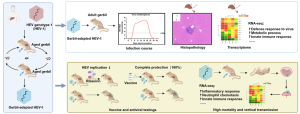Viral hepatitis caused by hepatitis A, B, C, D and E viruses (HAV to HEV) is of great concern worldwide because of the associated burden of illness and death. However, immunocompetent small animal models of human hepatitis viruses are still lacking, which impedes the study of virus-host interplay and the development of antiviral agents. Like HAV, HBV, and HCV, the host range of HEV-1 is restricted to humans. Previous studies investigating the pathogenesis of HEV-1 have relied heavily on non-human primates. However, high costs and ethical dilemmas associated with using these animals have hindered the accessibility and large-scale experimentation.
A research group led by Dr. Lin Wang in Peking University, Beijing, China found that Mongolian gerbil is susceptible to a clinical strain of HEV-1. After serial passage of this strain in aged male gerbils, the viral fitness has increased. Several mutations have been found in the viral genome of gerbil-adapted HEV-1 strain which may be associated with the increased fitness. The gerbil-adapted strain can efficiently infect adult gerbils and induce typical features of acute HEV-1 infection. Furthermore, the authors constructed a full-length infectious cDNA clone based on the adapted viral genome and successfully rescued the virus by intrahepatically inoculated the in vitro transcribed RNA to the gerbils.
Data regarding prevention and treatment of HEV-1 infection is limited. The authors demonstrated that this HEV-1 infection gerbil model can also be used in vaccine evaluation and antiviral drug testing. The successful application of HEV-1-infected gerbil model in testing therapeutic and preventive measures further extend the breadth of usage of this model. Moreover, the authors provide an in vivo model to study countermeasures against HEV-1. In future, more antiviral and vaccine candidates should be tested in this model.
Pregnant animal models of HEV are somewhat limited, as no immunocompetent small animal model can be infected with HEV-1. Next, the authors demonstrated the possibility of studying the adverse outcomes of HEV-1 infection in pregnant gerbils. High rates of maternal mortality and vertical transmission are associated with HEV-1 infection during the third trimester. Indeed, pregnant gerbils inoculated with HEV-1 at late-stage gestation showed high mortality rate while those inoculated at early-stage gestation survived. HEV RNA and infectious virions were detected in placental and fetal liver tissues, indicating vertical transmission. Interestingly, transcriptome analysis of the liver and placenta revealed that the upregulated genes were involved in neutrophil chemotaxis and inflammatory response, which are usually seen in antibacterial pathways but were recently reported in SARS-CoV-2 infection.

In summary, Wang and Liu confirm that the Mongolian gerbil is susceptible to HEV-1 by comprehensive experiments and report the establishment and characterization of HEV-1 infection gerbils. This model along with a reverse genetic system provide a well-suited immunocompetent in vivo tool for the study of the fundamental aspects of HEV-1. Furthermore, it can be used for the preclinical evaluation of novel antiviral therapies and vaccine candidates.
Read the full article online published in Gastroenterology (2024 Apr 5:S0016-5085(24)00364-0): DOI: 10.1053/j.gastro.2024.03.038

